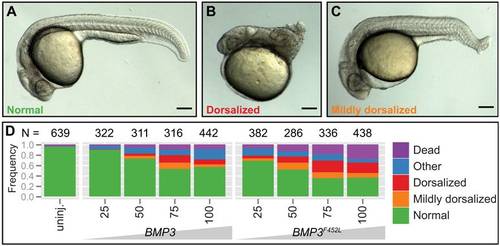Fig. S4
- ID
- ZDB-FIG-120824-26
- Publication
- Schoenebeck et al., 2012 - Variation of BMP3 Contributes to Dog Breed Skull Diversity
- Other Figures
- All Figure Page
- Back to All Figure Page
|
Overexpression activity differs between BMP3 variants. Overexpression utilized human BMP3 constructs, since the mature peptides of human and dog/wolf BMP3 are identical. (A–C) Whole mount embryos at embryonic stage 24 hpf, anterior to the left. Phenotypes are representative of (A) normal, (B) dorsalized, (C) mildly dorsalized classes following injection of human BMP3 mRNA into one-cell staged zebrafish embryos. (D) Stacked bar graph summarizing phenotypes observed following wt BMP3 or BMP3F452L mRNA injection. The dysmorphic phenotypes classified as “other” included combinations of mild dorsalization, tail curving, occlusion of the yolk extension, and invariably, hypoplasia or necrosis of head structures. Doses listed are in picograms (pg) of mRNA (x-axis). The frequencies of phenotypes are indicated by the y-axis. Each dose was repeated five or more times. The number of embryos injected is listed above each dose. Injection of BMP3F452L more potently dorsalizes embryos compared to wt BMP3 (student′s t-test P<0.05 for 25–75 pg doses, <0.01 for 100 pg dose). |

